Year after year, millions of people around the world look forward to one thing in the first week of December. And no, it’s not Christmas — it’s the annual Spotify Wrapped. Since its launch in 2015, Spotify’s annual year-in-review initiative has exponentially grown to become a viral cultural phenomenon that unequivocally marks the first week of December every year.
The combination of human-centric data storytelling and creative personalization catapulted Spotify to previously uncharted success, making it an excellent case study for brands and marketers that want to understand how to achieve cultural relevance, virality, and user retention in a scalable and sustainable way.
To put things into perspective, nearly 60 million Spotify Wrapped stories and graphics were shared across various social media platforms in 2021. The year after, over 156 million users engaged with Wrapped. From 2020 to 2021, there was a staggering 461% increase in the volume of tweets about Spotify Wrapped.
While these stats certainly indicate the staggering success of Spotify Wrapped as a user engagement and retention tactic, it also highlights the immense cultural impact it has and its ability to consistently spark organic conversations amongst users year after year.
With that in mind, let’s take a look at what exactly makes Spotify Wrapped so strategically impressive and take a deeper look at the psychology behind the “wrapped” formula that has now become much bigger than Spotify itself.
Why Data Storytelling Matters
The biggest reason why so many people resonate with Spotify Wrapped is because of the way it approaches data storytelling. Data storytelling, as the name suggests, is the practice of collating and analyzing large sets of user data to create a narrative that conveys clear, cohesive and creative insights to a specific audience.
Part of it is using data visualizations like charts, graphs, and maps to present the data in a digestible manner, but a large part of it is also about selecting the right datapoints, drawing relevant correlations, and weaving everything into a story that resonates with your target audience.
Spotify Wrapped excels at data storytelling because they make user data feel deeply personal and emotionally relevant. Instead of overwhelming users with raw numbers, Spotify distills users’ listening habits into engaging narratives that highlight individuality — your top artist becomes “your soundtrack,” your most-played song is “your anthem,” and your unique combinations of genres are celebrated as your “musical identity.” This approach transforms cold, hard stats into moments of self-discovery, allowing users to see themselves reflected in the data in a way that feels validating and fun.
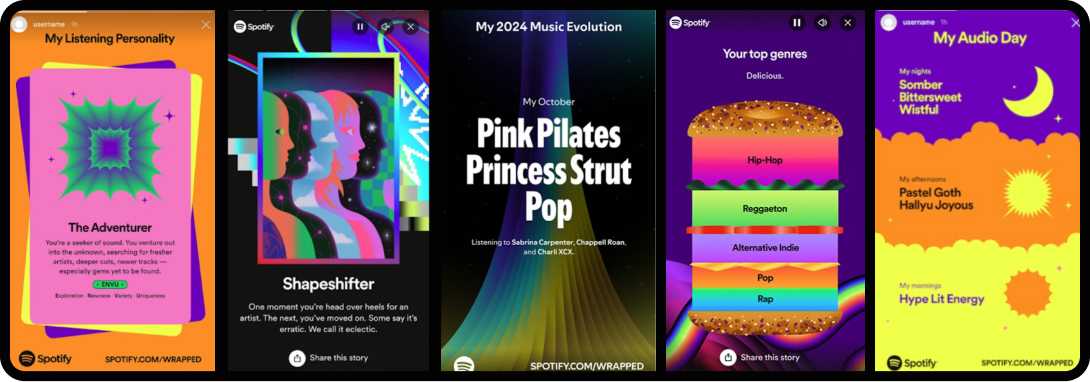
Why does this matter? Because storytelling is inherently human. Data storytelling bridges the gap between information and emotion, making even abstract or complex insights relatable and memorable.
By tapping into themes like nostalgia, identity, and social connection, Spotify Wrapped creates a powerful experience that resonates on a personal level while also encouraging users to share their stories with others.
Creating FOMO to Encourage Social Sharing
Spotify Wrapped is no doubt great at resonating with its users through data storytelling — but that’s only half the story. In addition to engaging with existing users, a good marketing strategy needs to be able to reach and acquire new users as well. That’s where FOMO and organic social sharing come into play.
In the first week of December 2020, Spotify saw a 21% increase in mobile app downloads after the year’s Spotify Wrapped was released. This was largely driven by FOMO (Fear of Missing Out) and the viral nature of social sharing.
Spotify Wrapped creates an annual cultural moment that users don’t want to miss out on, especially as their friends, favorite influencers, and even brands flood social media with personalized Wrapped recaps. The campaign transforms Spotify from just a music streaming app into a social badge of identity and taste. Seeing everyone else’s Wrapped stories can compel non-users to sign up, just so they can participate and share their own data-driven highlights.
What makes Spotify Wrapped even more effective for awareness driving and user acquisition is how it’s designed for maximum visual and social impact. Spotify crafts its Wrapped graphics to be vibrant, playful, and perfectly formatted for channels like Instagram Stories.
The bold colors, quirky animations, and bite-sized, scrollable slides are optimized for quick consumption and effortless sharing. Each stat, from “your most-streamed artist” to “minutes listened,” is displayed in a way that feels like an achievement worth bragging about.
To encourage users to share their Wrapped, Spotify prominently features a share button in-platform, making it easy for users to instantly post their results to social media. This deliberate design ensures that each user’s Wrapped becomes a shareable asset, sparking more conversations, likes, and curiosity — further driving FOMO for non-users and reinforcing Spotify’s cultural relevance.
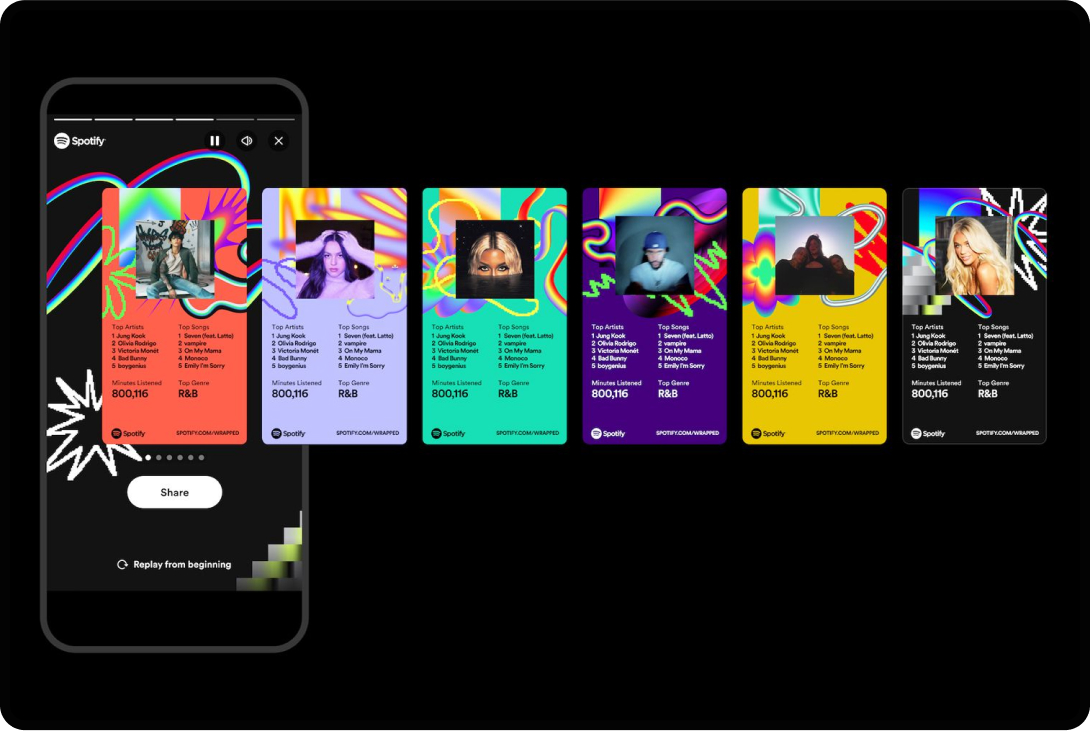
For existing users, Spotify Wrapped taps into the deeply personal nature of music as a marker of identity. Sharing your Wrapped isn’t just about showcasing your top songs or favorite artists — it’s a way to signal who you are and what you care about.
Music taste often acts as a conversation starter and a way for people to connect with one another, whether it’s bonding over a shared love for a niche indie band or debating the merits of a trending pop artist. Wrapped transforms these personal preferences into shareable content that invites others to engage, fostering a sense of belonging and sparking conversations both online and offline.
This emotional resonance encourages users to keep engaging with Spotify year-round. Knowing that their listening habits will culminate in a personalized Wrapped experience motivates users to stay active on the platform, explore new music, and create habits they’ll look forward to seeing reflected in December.
Additionally, the social-sharing aspect incentivizes users to remain loyal to Spotify over competing platforms — after all, only Spotify offers this highly anticipated experience (Apple Music has arguably tried and failed to replicate Spotify’s success).
Spotify Wrapped vs. Apple Music Replay
What about Apple Music Replay?
Apple Music Replay is Apple’s answer to Spotify Wrapped, offering users a recap of their listening habits over the past year. While the concept is similar — highlighting top songs, artists, and albums — Replay struggles to capture the same level of excitement, cultural relevance, and viral appeal that Spotify Wrapped has mastered.
Despite being one of the most prominent competitors in the music streaming space, Apple Music’s attempt to emulate Spotify’s year-end campaign often falls short in both execution and impact.
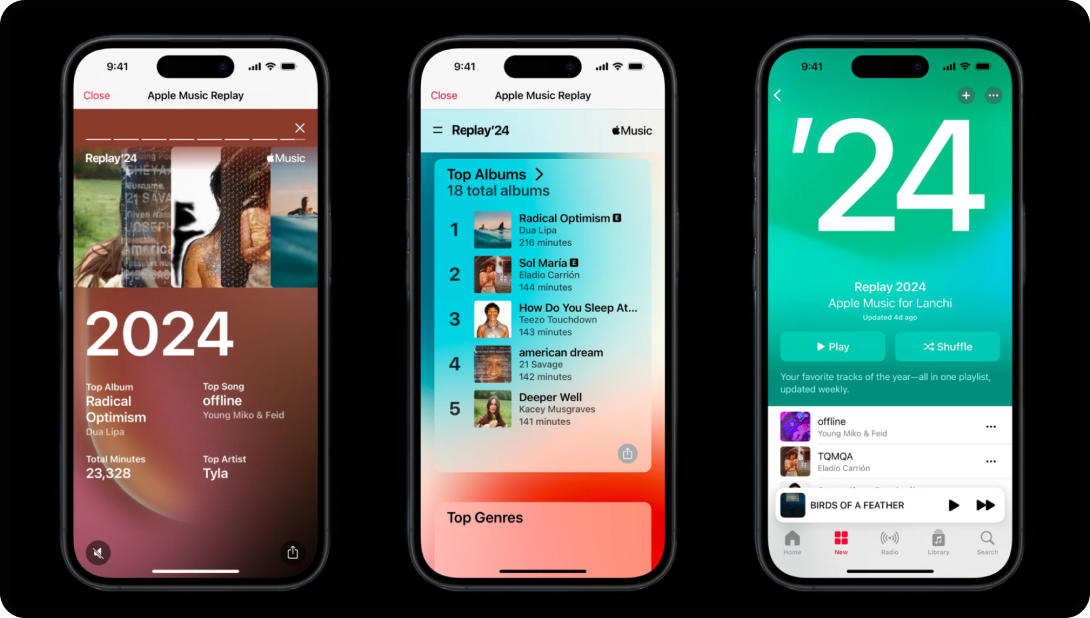
One major difference lies in the presentation. While Spotify Wrapped dazzles users with bold, dynamic graphics and animations tailored for social sharing, Apple Music Replay is comparatively understated. Its interface feels more utilitarian than celebratory, lacking the vibrant design elements that make Wrapped so fun to share.
Replay also misses the mark on storytelling — where Spotify excels at weaving users’ listening data into a personalized narrative, Apple Music’s recap feels more like a static report. The emotional resonance that comes from celebrating music as part of one’s identity is largely absent.
Additionally, Apple Music Replay doesn’t generate the same buzz on social media. Spotify Wrapped’s viral success comes not only from its shareable design but also from its ability to create a cultural moment each December.
In contrast, Replay feels like an afterthought, released quietly and without the fanfare that makes Wrapped so highly anticipated. As a result, Replay struggles to inspire the same FOMO that drives non-users to download Spotify and join the conversation.
While Apple Music Replay is a nice-to-have feature for existing subscribers, it lacks the strategic brilliance of Spotify Wrapped as a tool for user acquisition, retention, and cultural impact.
Spotify Popularized the “Wrapped” Formula
The true indication of cultural impact is when a brand initiative begins to create ripple effects across other brands, communities, and individuals that may not even necessarily be related to the original brand. Spotify not only pioneered the concept of a year-end listening recap with Wrapped but also turned it into a cultural phenomenon that transcends the platform itself.
What began as a clever marketing strategy for the music streaming app has now become a blueprint for brands across industries, from media tracking apps like Letterboxd to lifestyle tools like Beli and Oura Ring.
Each of these brands has adopted its own version of an annual “wrapped” or “recap,” showcasing personalized data to engage users and celebrate individuality. Similar to Spotify Wrapped, brands are using user data to create interesting data stories that go a step further than simple data visualizations, such as Oura showing which element you’re most like, or Beli highlighting what your dream dinner party might look like.
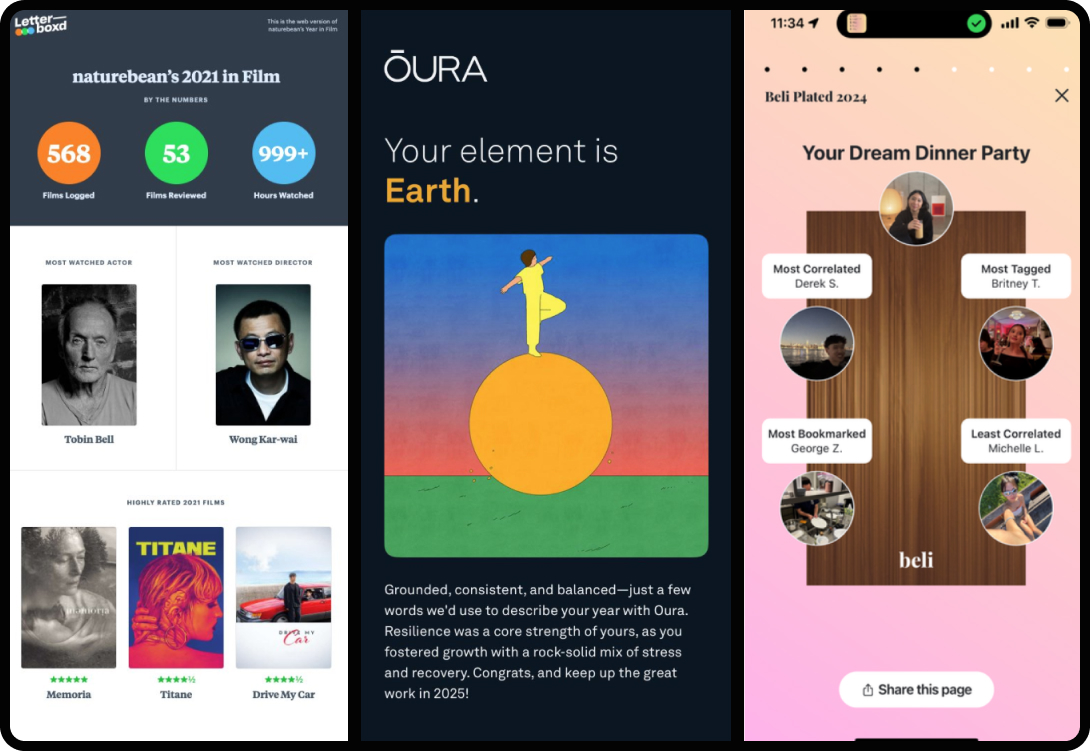
The influence of the “wrapped” formula goes beyond just brands, too. In recent years, TikTok users have popularized a “Dating Wrapped” trend that takes the year-end recap phenomenon to a whole new level through a combination of humor, creativity, and self-reflection.
Inspired by the viral success of Spotify Wrapped, individual users and creators have begun crafting their own personalized presentations that break down their romantic escapades over the past year. These DIY recaps often include statistics like the number of first dates they went on, how many ended in ghosting, their “most compatible zodiac sign,” or even a highlight reel of their “top 3 cringe moments.”
Beyond its comedic value, “Dating Wrapped” is an indication of a societal shift around being more and more comfortable with turning data into markers of identity and storytelling. Just as Spotify Wrapped highlights a user’s music tastes as a reflection of who they are, Dating Wrapped transforms relationship highs and lows into a badge of individuality.
It shows how people are increasingly using personal data — whether tracked meticulously or exaggerated for laughs — as a way to connect with others and make sense of their year. This trend underscores the cultural resonance of the “Wrapped” formula and how it has become a creative outlet for everything from brands to personal milestones.
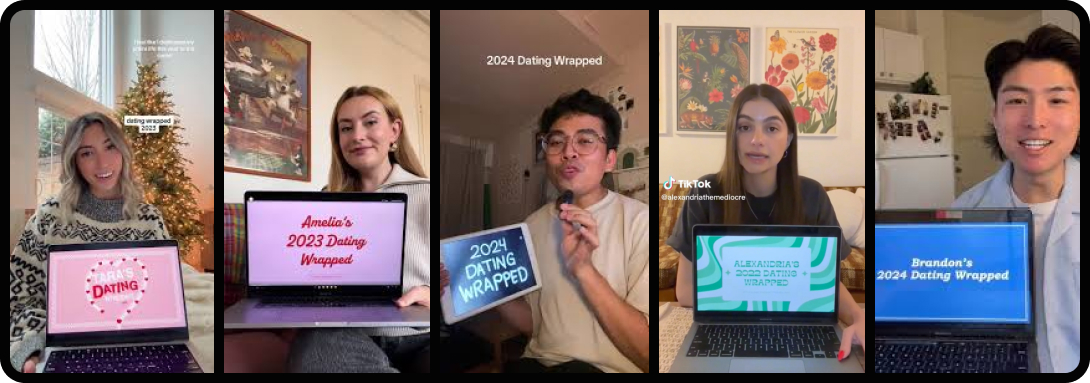
What’s Next for Spotify Wrapped: Navigating the Rise of AI and an Increasingly Crowded Space
Is 2025 the year we see the downfall of Spotify Wrapped? Although Spotify Wrapped has a long history of success, users were quick to point out that the 2024 Spotify Wrapped felt lackluster and underwhelming compared to previous years.
For their 2024 Wrapped, Spotify teamed up with Google AI’s NotebookLM and made their year all about their AI-generated personalized podcast. This AI podcast dives into your favorite tracks and artists and explores the evolution of your music taste this year — but that’s not what Spotify users wanted to see.
Here’s a hot take: Just because something’s AI-driven doesn’t automatically make it interesting. In previous years, Spotify dropped unconventional data moments like listening personality types and city matches, but in 2024 there was none. Spotify Wrapped is a viral moment each year for a reason, and personalization and data-driven insights are at the heart of what makes Spotify Wrapped so much better than Apple Music Replay.
Given that the 2024 Spotify Wrapped lacked the human touch that their AI podcast couldn’t mimic, the negative reaction from the community creates a challenge for Spotify to step up their game in the following years to regain the excitement around the cultural phenomenon that they built from the ground up.
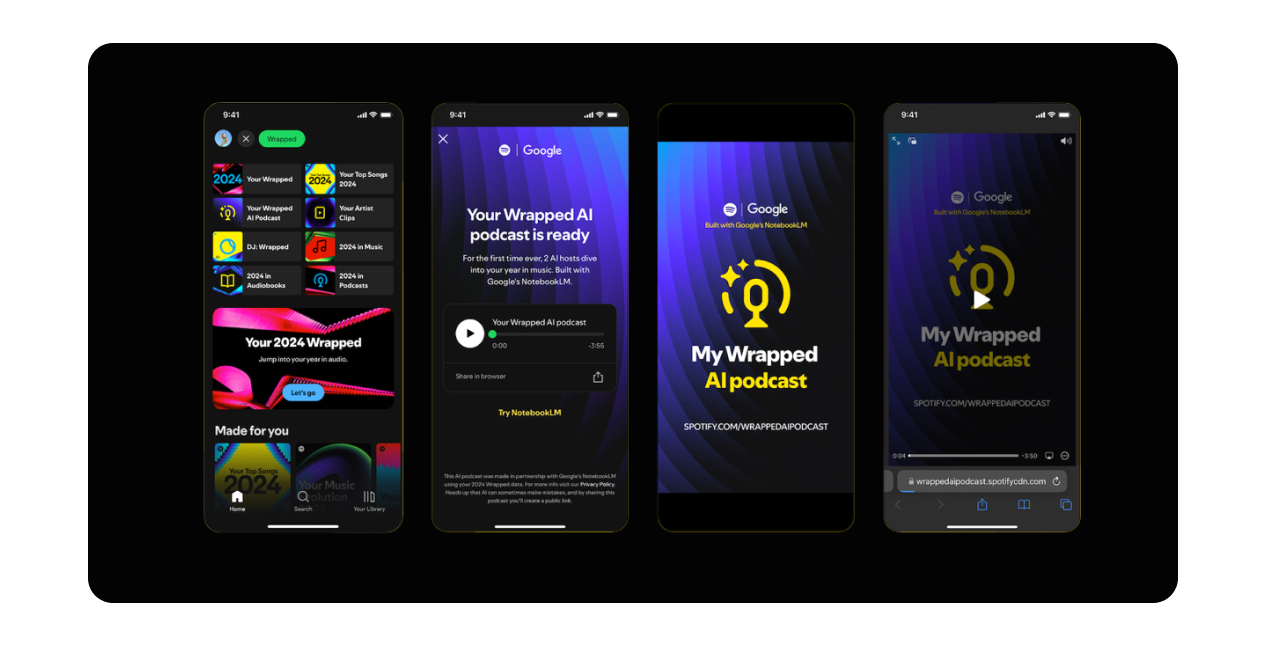
As Spotify Wrapped enters its next chapter, the rise of AI presents both opportunities and challenges for the platform. AI tools can revolutionize the depth of personalization Wrapped offers, enabling Spotify to surface even more nuanced insights about users’ listening habits. Imagine AI-generated playlists based on subtle shifts in mood across the year or hyper-detailed predictions of emerging music trends tailored to individual tastes.
However, as the 2024 iteration demonstrated, leaning too heavily on AI without preserving the human-centric storytelling that Wrapped is known for can alienate users. The backlash to the AI-driven podcast experiment highlights an important lesson: technology should enhance the experience, not overshadow the creativity and emotional connection that make Wrapped resonate.
Spotify Wrapped now also faces an external challenge — standing out in a crowded space where the “Wrapped” formula is no longer unique. With countless brands replicating its recap-style approach, Spotify must find new ways to keep the experience fresh and culturally significant.
Wrapped’s earlier success relied on being groundbreaking, but as the novelty wears off, maintaining relevance requires reinvention. Spotify has already proven its ability to innovate with features like listening personality types and quirky, unexpected insights. The key to the future lies in doubling down on these creative elements while finding ways to reimagine the tradition in ways that surprise and delight users once again.
As Spotify navigates these challenges, its ability to balance technological advancement with creative ingenuity will determine whether Wrapped continues to set the gold standard for year-end recaps — or becomes just another trend in the crowded field it helped create.






